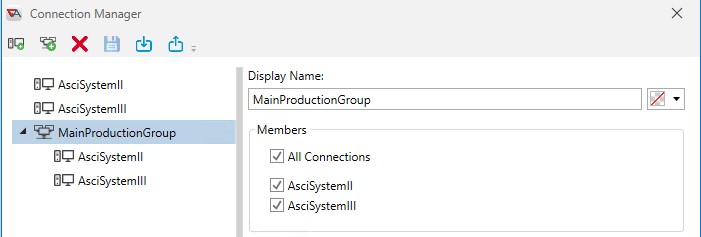Job Scheduler Groups
This feature allows you to see combined data from two or more production Job Schedulers, in 4 AbatConsole views.
When you connect to a Job Scheduler, the connection and information retrieved is specific to the connected Job Scheduler. This is true, even when you connect to multiple schedulers using a single session of AbatConsole. Each Scheduler tab in AbatConsole displays information only for the currently selected Scheduler.
ActiveBatch also provides the ability to group Job Schedulers such that the information provided is aggregated for the group of connected Job Schedulers. This means that data (for specific views only) is combined from two or more Schedulers. If you choose to use this feature, the Scheduler group should be created for the same type of Scheduler environment, which would typically be two or more production Job Schedulers. You should not create a group to combine Test Scheduler data with Production Scheduler data (or similar heterogeneous environments).
This data aggregation can be very useful when you are using Job Schedulers for scalability purposes and/or to maintain high availability. The aggregation of data provides a single consolidated view into what is essentially a grouping of Job Schedulers. There are 4 views that support aggregated data, and they are:
To create a Group, either click on the ActiveBatch menu item, then select Connect or press the F4 key to launch the Connection Manager. The second icon from the left allows you to create a “New Group…”.
Note: If the “New Group…” command is grayed out and disabled then your ActiveBatch Administrator has prevented you from creating your own groups. In addition, as you read this section, if the management-type operations are grayed out, this means that your ActiveBatch Administrator has prevented you from making changes to groups.
When you select the New Group operation, a new entry is made in the Connection Manager’s Connection List, and you can enter the name of your new group. With the new group name entered, you can expand the group to see: 1) views that provided aggregated or consolidated information and 2) members of the group. Members of a group are one or more Job Schedulers and/or specifications (while the minimum is one; at least two are required for any real aggregation of information).

To add Job Schedulers and/or Virtual Root connections to the group, you can right-click on the Group Name (for example, MainProductionGroup in the figure above) and select the “Add Member” operation. This creates a new connection for that member. When your members are added, you can select the Group (for example, MainProductionGroup) and click the “Connect” button to connect to the group.

Once your group is connected you can access the aggregated (consolidated) views. This allows you to see all connected systems in a single view.
Additional operations within the Connection Manager allow you to Disconnect/Remove each member or to Disconnect/Remove all members.
Next, to delete a Group, right-click on the group you wish to delete and select “Delete…”. This operation, when confirmed, will delete the group.
Note: When performing a Group connect, only the consolidated views are shown. To obtain Object Navigation for each connected Job Scheduler, you must connect to each Job Scheduler directly.